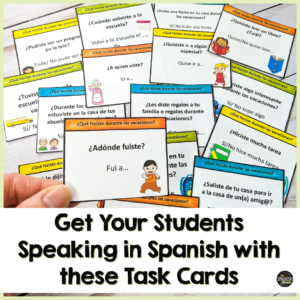Third quarter rolls around & so does the chapter where we heave to teach the past tense in Spanish. I can already feel the knot in my stomach growing before the lesson even begins. The running dialogue in my head starts…. “They’re gonna hate it. So many are going to fail the common assessment. It’s a waste of time. Why do we teach this in Spanish 2?”
It took me years to change my mindset on this. I knew that I hadn’t mastered preterite & imperfect until I studied abroad. Why? Because I heard it being used Every. Single. Day. It was only after constant repetition that it finally sunk into my brain. No one in Madrid showed me conjugation charts, or corrected me if I slightly messed up my verb endings, or stopped our conversation to explain to me the “rules” about why we use the imperfect to talk about age. So then why are we doing this in our classrooms?
So how can we best model this situation in our classroom? We must give our students a lot of exposure to the language in context. Start by focusing on their comprehension of the language. Don’t stress about output, it will come with time.
Here are some quick tips on what to do and avoid when teaching those tricky grammar concepts like preterite & imperfect.
Donts:
- Focus solely on conjugation. This will come with lots of time and repetition.
- Expect them to master it after only a few short weeks (remember how long it took you to get it, right?). Give both yourself and your students a lot of patience.
- Force output right away. They need to hear & see it A LOT before they can produce it naturally.
Dos:
- Give tons of comprehensible input. (See my blog post here)
- Focus on high frequency verbs that are essential for communication. Yep, that includes those irregulares.
- Use the preterite and imperfect in context.
Good luck! Let me know how your experience with past tense is going. What works? What doesn’t?





No Comments